- Home
- Truman Capote
Other Voices, Other Rooms
Other Voices, Other Rooms Read online
Table of Contents
Title Page
Dedication
Epigraph
INTRODUCTION
PART ONE
ONE
TWO
THREE
FOUR
FIVE
PART TWO
SIX
SEVEN
EIGHT
NINE
TEN
ELEVEN
PART THREE
TWELVE
About the Author
Copyright Page
FOR NEWTON ARVIN
The heart is deceitful above all things, and desperately wicked.
Who can know it?
JEREMIAH 17:9
INTRODUCTION
John Berendt
As Truman Capote remembered it years later, the idea for Other Voices, Other Rooms came to him in the form of a revelation during a walk in the woods. He was twenty-one, living with relatives in rural Alabama, and working on a novel that he had begun to fear was “thin, clever, unfelt.” One afternoon, he went for a stroll along the banks of a stream far from home, pondering what to do about it, when he came upon an abandoned mill that brought back memories from his early childhood. The remembered images sent his mind reeling, causing him to slip into a “creative coma” during which a completely different book presented itself and began to take shape, virtually in its entirety. Reaching home after dark, he skipped supper, put the manuscript of the troublesome unfinished novel into a bottom bureau drawer (it was entitled “Summer Crossing,” never published, later lost), climbed into bed with a handful of pencils and a pad of paper, and wrote: “Other Voices, Other Rooms—a novel by Truman Capote. . . . Now a traveler must make his way to Noon City by the best means he can . . .”1
Whether or not Capote’s remarkable first novel came to him as he said it did, in a spontaneous flow of words as if dictated by “a voice from a cloud,” the work that emerged two years later was as lyrical and rich in poetic imagery as if it had been written by a writer possessed.
The setting of Other Voices, Other Rooms is the rural South of Capote’s youth rather than New York, where “Summer Crossing” had been set. Capote’s impressionist prose style creates an atmosphere of dreamlike elegance: “the white afternoon was ripening towards the quiet time of day when the summer sky spills soft color over the drawn land”; and at night, “a vine-like latticework of stars frosted the southern sky.” His narrative glows with an abundance of colors, some of which seem to have been invented on the spot: “The wagon’s rickety wheels made dust clouds that hung in the green air like powdered bronze.” He is no less ingenious in drawing character portraits, for example, the century-old black mule-driver, Jesus Fever, whose “face was like a black withered apple, and almost destroyed; his polished forehead shone as though a purple light gleamed under the skin.” As for the crotchety stepmother, Miss Amy: “Her voice had a weary, simpering tone; it struck the ear like the deflating whoosh of a toy balloon.” Capote fills the page with evocative images, one after the other, from fairy-tale sweet to downright eerie—as in the swampy ruins of the Cloud Hotel where in the ballroom “a fallen chandelier jeweled the dust, and weather-ripped draperies lay bunched on the waltz-waved floor like curtsying ladies”; and where “water-snakes slithering across the strings made night-songs on the ballroom’s decaying piano.”
This is bravado wordplay—exuberant, brilliant, daring, and unabashedly ostentatious. The genre is pure Southern Gothic, set deep in a lush and mysterious terrain full of Spanish moss, overgrown gardens, and “swamplike hollows where tiger lilies bloom the size of a man’s head.” Capote christens his places with names that carry allegorical nuances: Noon City, Paradise Chapel, Skully’s Landing, the Cloud Hotel, the Drownin Pond. His characters are a collection of misfits, eccentrics, and oddballs, any one of whom would have been at home in virtually any story written by William Faulkner, Carson McCullers, Tennessee Williams, or Flannery O’Connor—even characters with minor roles: the one-armed barber; the traveling-show midget, Miss Wisteria; and the saloon-keeper, Miss Roberta, who toys with the single hair growing out of a wart on her chin.
Other Voices, Other Rooms is the story of Joel Harrison Knox, a thirteen-year-old boy who was raised in New Orleans and, after his mother’s death, is sent to the rural South to live with his father who had abandoned him when he was an infant. Joel’s journey to his new home takes him to ever-smaller towns over less-traveled roads through yet murkier landscapes to the overgrown and nearly deserted Skully’s Landing. There, in a half-ruined mansion with neither electricity nor indoor plumbing, he meets his father, a bedridden, near-mute invalid who communicates by tossing red tennis balls from his bed onto the floor. Other members of this strange household include Joel’s strait-laced stepmother, her effeminate “silver-tongued” cousin Randolph, the old black mule-driver, and the mule-driver’s granddaughter, Missouri “Zoo” Fever.
Capote at first denied that Other Voices, Other Rooms was autobiographical. And yet, like the fictional Joel Knox, Capote had been born in New Orleans, longed to see his absent father, was sent as a young boy into the rural South to live with relatives, and took his mother’s last name, not his father’s. Capote’s description of Joel as “too pretty, too delicate and fair-skinned” could have been a self-portrait, as could the observation that “a girlish tenderness softened his eyes” and that “his voice was uncommonly soft.” Capote was taunted for his effeminacy; Joel is called “sissy-britches.” The tomboy Idabel is based on Capote’s childhood friend the writer Harper Lee, and the fretful Miss Amy is reminiscent of one of the relatives Capote lived with in Alabama, Callie Faulk.
Twenty years after publication, Capote recanted somewhat. He admitted having come to realize that Other Voices had been an unconscious, intuitive attempt to exorcise his demons. “I was not aware,” he wrote in the November 1967 Harper’s, “except for a few incidents and descriptions, of its being in any serious degree autobiographical. Rereading it now, I find such self-deception unpardonable.”2
To call it “unpardonable” seems a bit harsh. In order to create fictional characters and give them thoughts, speech patterns, mannerisms, and motives, writers have little choice but to draw on people they have known, including themselves, even though they may have no intention of writing an autobiography. Capote had done so repeatedly in his short stories. No matter how vivid the writer’s imagination, it is inevitable that his characters, however original they may seem on the page, will have antecedents in the real world, as stored in some form somewhere in the author’s mind. So it is not surprising to find traces of an author’s psychological DNA in his fictional characters—all of his fictional characters, not just the ones who resemble himself.
Few first novels have created as much prepublication excitement as Other Voices, Other Rooms. Before its release in January 1948, the twenty-three-year-old Capote had published only a handful of very good short stories, and he had already become the talk of literary circles. Twentieth Century-Fox had optioned the movie rights for Other Voices sight unseen, and Life magazine had given Capote the most prominent display in a feature about young American writers, even though all the other writers covered in the story, including Gore Vidal and Jean Stafford, were better known at the time and had already published at least one novel. 3
It was not solely on the basis of Capote’s then-meager literary output that he managed to find himself in the spotlight. He had already become something of a personality in New York, and a very strange personality at that. He stood a diminutive five feet three, had a childlike face, blond bangs, a pixieish manner, a knack for drawing attention to himself, and an unflagging determination to be famous. Brendan Gill recalled that when Capote work
ed as a copyboy at The New Yorker at the age of seventeen, he looked “as exotic as an osprey,”4 with his round face, his shoulder-length blond hair, and his occasional opera cape. Upon catching sight of him in the hallway for the first time, the magazine’s editor, Harold Ross, cried out, “For God’s sake! What’s that?”5
In a year that also saw the publication of Norman Mailer’s The Naked and the Dead and Irwin Shaw’s The Young Lions, Capote’s book held its own. Critical response was, on balance, favorable. Canceling out the barb hurled by Carlos Baker in the Sunday New York Times Book Review (“The story of Joel Knox did not need to be told, except to get it out of the author’s system”6), the daily critic of the Times, Orville Prescott, praised “the potent magic of [Capote’s] writing” and declared that the book was “positive proof of the arrival of a new writer of substantial talent.”7
Discussion of the literary worth of Other Voices, however, became entangled with, and at times overshadowed by, even livelier talk about the provocative photograph that adorned the back of the dust jacket. The photograph, taken by Harold Halma, showed an androgynous, barely post-pubescent Capote lounging on a sofa in a sultry pose, looking seductively into the camera. The photograph caused a furor, and Capote was anguished that the distraction would take attention from the book and damage his reputation as a serious writer. He protested that the photograph had been a candid shot, taken when he was not aware of it, and that furthermore he had not been consulted on its use for the book jacket. Neither was true. In any case, this was an early episode in a pattern that would continue throughout his career: Capote’s personal publicity upstaging his own work. But at least Capote got what he wanted; he had become famous.
The broad themes of Other Voices are classic fare: a boy’s search for his absent father, the terror of abandonment, the misery of loneliness, the yearning to be loved, and finally the progression from childhood to something approaching adulthood.
Loneliness and love figure frequently in Capote’s fiction. In the short story “House of Flowers,” Ottilie asks, “How do you feel when you’re in love? . . . Ah, said Rosita with swooning eyes, you feel as though pepper has been sprinkled on your heart, as though tiny fish are swimming in your veins.”8 In the novella The Grass Harp, Judge Cool explains that love is part of a grand plan: “A leaf, a handful of seed—begin with these, learn a little what it is to love. First, a leaf, a fall of rain, then someone to receive what a leaf has taught you, what a fall of rain has ripened. No easy process, understand; it could take a lifetime . . . love is a chain of love, as nature is a chain of life.”9 And in Other Voices, there is Cousin Randolph: “any love is natural and beautiful that lies within a person’s nature; only hypocrites would hold a man responsible for what he loves.”
Joel Knox’s journey to Skully’s Landing is a symbolic and highly stylized voyage into his (and Truman Capote’s) subconscious. Once Joel has confronted and finally moved beyond the problem of his absent, uncommunicative father, the remaining demons to be exorcised are all wrapped up in the question of identity: Who is Joel Knox? By the conclusion of the book, Joel is at last able to shed his self-doubts and whoop joyously: “I am me . . . I am Joel, we are the same people.”
The answer—or at least the way toward an answer—is provided by the fey-but-wise Cousin Randolph, who becomes the main spokesman for the book. The mysterious white-haired lady in the window is Randolph got up in an old Mardi Gras costume, beckoning to Joel, who, knowing he must go to her, turns and looks back “at the boy he had left behind.”
Most critics assumed, and understandably so, that by going to the lady in the window, Joel realizes that, like Capote himself, he will live his life as a homosexual. Capote, however, insisted he had never intended anything as definite as that; in fact, he said he had never given any thought to what Joel would be like at the age of thirty or forty. It was enough, for now, that Joel had emerged from the terrors of his boyhood.
But Cousin Randolph was, of course, unabashedly homosexual. One of the most compelling passages in the book is the long monologue in which he recalls his passion for a Mexican prizefighter and delivers a poignant disquisition on love. Capote was ahead of his time. This was 1948. In its review, Time decried what it called “the distasteful trappings” of the book’s homosexual theme. Newsweek called the book “a deep, murky well of Freudian symbols.”10 Diana Trilling, writing an otherwise admiring review for The Nation, came to the unjustified and somewhat naïve conclusion that Capote was trying to say that “a boy becomes a homosexual when the circumstances of his life deny him the other, more normal gratifications of his need for affection.” 11
Though he would go on to write more fiction after Other Voices, Other Rooms, Capote soon gravitated to nonfiction. Using real people as subjects excited him more. Two long articles in The New Yorker —“The Muses Are Heard,” in which Capote traveled to Moscow with an American touring company of Porgy and Bess, and “The Duke in His Domain,” a stunningly candid profile of Marlon Brando— made it clear that Capote was as gifted a journalist as he was a novelist. He knew instinctively how to disarm his subjects and draw them out. As he devoted more of his efforts to reportage, his style turned sober and spare, and the poetic images all but disappeared.
Skimming the pages of In Cold Blood, his 1966 “nonfiction novel” based on the murder of four members of a Kansas family, one can still detect in the stark, crystalline prose something of the poet Capote had left behind: “Steps, noose, mask; but before the mask was adjusted, the prisoner spat his chewing gum into the chaplain’s outstretched palm. Dewey shut his eyes; he kept them shut until he heard the thud-snap that announces a rope-broken neck.”12
Capote’s nonfiction increased his fame substantially, but the lyrical Capote eventually had the final word: “The brain may take advice, but not the heart, and love, having no geography, knows no boundaries.” The line, spoken by Cousin Randolph in Other Voices, Other Rooms, is engraved on Capote’s memorial stone in Bridgehampton, Long Island.
JOHN BERENDT is the author of Midnight in the Garden of Good and Evil. He lives in New York.
NOTES
1. “Voice from a Cloud,” reprinted in The Dogs Bark, Random House, 1973, pp. 6–7.
2. Ibid., p. 4.
3. Capote: A Biography, by Gerald Clarke, Carroll & Graff, 1988, p. 131.
4. Conversations with Capote, by Lawrence Grobel, Da Capo Press, 1985, p. 31.
5. Clarke, p. 71.
6. Ibid., p. 155.
7. Ibid., p. 156.
8. “House of Flowers,” collected in the Modern Library edition of Breakfast at Tiffany’s, pp. 108–109.
9. The Grass Harp, Vintage (U.S. edition), p. 44.
10. Clarke, p. 155.
11. Truman Capote, ed. George Plimpton, Anchor Books, 1998, p. 79.
12. In Cold Blood, Penguin (U.K. edition), p. 333.
PART ONE
ONE
Now a traveler must make his way to Noon City by the best means he can, for there are no buses or trains heading in that direction, though six days a week a truck from the Chuberry Turpentine Company collects mail and supplies in the next-door town of Paradise Chapel: occasionally a person bound for Noon City can catch a ride with the driver of the truck, Sam Radclif. It’s a rough trip no matter how you come, for these washboard roads will loosen up even brandnew cars pretty fast; and hitchhikers always find the going bad. Also, this is lonesome country; and here in the swamplike hollows where tiger lilies bloom the size of a man’s head, there are luminous green logs that shine under the dark marsh water like drowned corpses; often the only movement on the landscape is winter smoke winding out the chimney of some sorry-looking farm-house, or a wing-stiffened bird, silent and arrow-eyed, circling over the black deserted pinewoods.
Two roads pass over the hinterlands into Noon City; one from the north, another from the south; the latter, known as the Paradise Chapel Highway, is the better of the pair, though both are much the same: desolate miles of swamp and field and fore
st stretch along either route, unbroken except for scattered signs advertising Red Dot 5¢ Cigars, Dr. Pepper, NEHI, Grove’s Chill Tonic, and 666. Wooden bridges spanning brackish creeks named for long-gone Indian tribes rumble like far-off thunder under a passing wheel; herds of hogs and cows roam the roads at will; now and then a farm-family pauses from work to wave as an auto whizzes by, and watch sadly till it disappears in red dust.
One sizzling day in early June the Turpentine Company’s driver, Sam Radclif, a big balding six-footer with a rough, manly face, was gulping a beer at the Morning Star Café in Paradise Chapel when the proprietor came over with his arm around this stranger-boy.
“Hiya, Sam,” said the proprietor, a fellow called Sydney Katz. “Got a kid here that’d be obliged if you could give him a ride to Noon City. Been trying to get there since yesterday. Think you can help?”
Radclif eyed the boy over the rim of his beer glass, not caring much for the looks of him. He had his notions of what a “real” boy should look like, and this kid somehow offended them. He was too pretty, too delicate and fair-skinned; each of his features was shaped with a sensitive accuracy, and a girlish tenderness softened his eyes, which were brown and very large. His brown hair, cut short, was streaked with pure yellow strands. A kind of tired, imploring expression masked his thin face, and there was an un-youthful sag about his shoulders. He wore long, wrinkled white linen breeches, a limp blue shirt, the collar of which was open at the throat, and rather scuffed tan shoes.
Wiping a mustache of foam off his upper lips, Radclif said: “What’s you name, son?”
“Joel. Jo-el Har-ri-son Knox.” He separated the syllables explicitly, as though he thought the driver deaf, but his voice was uncommonly soft.
“That so?” drawled Radclif, placing his dry beer glass on the counter. “A mighty fancy name, Mister Knox.”
The boy blushed and turned to the proprietor, who promptly intervened: “This is a fine boy, Sam. Smart as a whip. Knows words you and me never heard of.”

 In Cold Blood
In Cold Blood The Grass Harp, Including a Tree of Night and Other Stories
The Grass Harp, Including a Tree of Night and Other Stories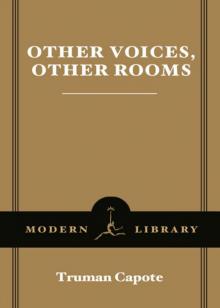 Other Voices, Other Rooms
Other Voices, Other Rooms Breakfast at Tiffany's
Breakfast at Tiffany's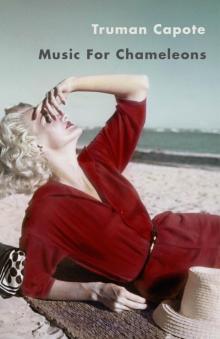 Music For Chameleons
Music For Chameleons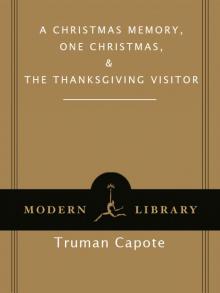 A Christmas Memory, Including One Christmas and the Thanksgiving Visitor
A Christmas Memory, Including One Christmas and the Thanksgiving Visitor Summer Crossing
Summer Crossing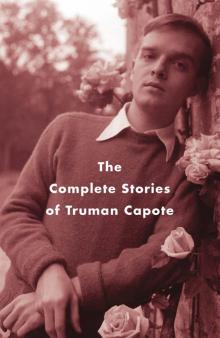 The Complete Stories of Truman Capote
The Complete Stories of Truman Capote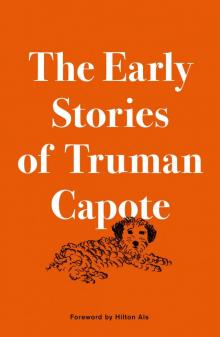 The Early Stories of Truman Capote
The Early Stories of Truman Capote Answered Prayers
Answered Prayers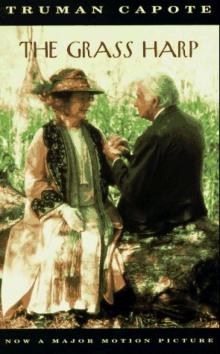 The Grass Harp
The Grass Harp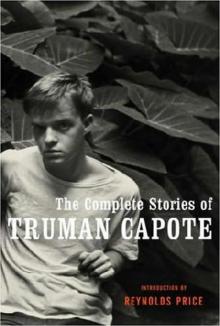 SSC (2004) The Complete Stories of Truman Capote
SSC (2004) The Complete Stories of Truman Capote A Christmas Memory
A Christmas Memory